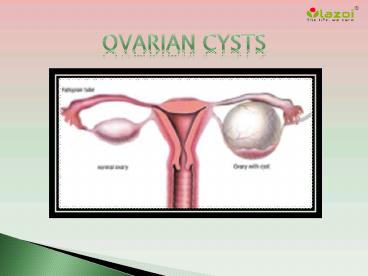Ovarian Cysts: Common Uterine Conditions - PowerPoint PPT Presentation
Title:
Ovarian Cysts: Common Uterine Conditions
Description:
An ovarian cyst is a sac filled with fluid or a semisolid material that forms on or within one of the ovaries, the small organs in the pelvis that make female hormones and hold egg cells. – PowerPoint PPT presentation
Number of Views:144
Title: Ovarian Cysts: Common Uterine Conditions
1
Ovarian Cysts
2
Ovarian Cysts
- An ovarian cyst is a sac filled with fluid or a
semisolid material that forms on or within one of
the ovaries, the small organs in the pelvis that
make female hormones and hold egg cells.There
are different types of cysts, many of which are
normal and harmless (benign). Functional cysts,
which are not disease-related, occur as a result
of ovulation (the release of an egg from the
ovary). Functional cysts generally shrink over
time, usually within 60 days, without specific
treatment. Functional ovarian cysts, which are
relatively common, should not be confused with
other types of cysts that are disease-related.
Conditions such as polycystic ovary
syndrome and ovarian cancer also involve growths
on the ovaries. Tell your gynaecologist if you
have any of the symptoms listed below. He or she
can determine the type of cyst you have.
3
Symptoms
- Some smaller cysts cause no symptoms you may not
even know you have a cyst. Larger cysts may cause
the following symptoms - Pelvic pain or a dull ache in your back
- A feeling of fullness (bloating) in your lower
belly - Pain during intercourse
- Painful periods
- Some prolonged symptoms may be associated with a
condition called polycystic ovary syndrome,
a hormonal imbalance that causes irregular
periods and other hormone-related problems,
including obesity and infertility. Other symptoms
of polycystic ovary syndrome include Hirsutism
(increased growth of body hair) and obesity. The
exact cause of ovarian cysts is not known.
4
How is an ovarian cyst diagnosed?
- Your gynaecologist will first rule out pregnancy
as the cause of your symptoms. He or she then may
use the following tests to diagnose an ovarian
cyst - A pelvic examination During this exam, the
doctor uses an instrument to widen the vagina,
which allows the doctor to examine the vagina,
cervix and uterus. The doctor also feels the
reproductive organs for any lumps or changes. - Blood tests These tests are used to measure the
levels of certain hormones in the blood. - Ultrasound This test uses sound waves to create
images of the body's internal organs. It can be
used to detect cysts on the ovaries.
5
Treatments
- Functional ovarian cysts generally go away
without treatment. Your health care provider may
give you medications containing hormones (such as
birth control pills) to stop ovulation. If you do
not ovulate, you will not form functional cysts.
In some cases, surgery may be necessary to remove
a cyst. Types of surgeries to remove ovarian
cyst The type of surgery used depends on the
size of the cyst and how it appears on the
ultrasound. The different procedures used
include - Laparoscopy This is a procedure in which the
doctor inserts a small device through an incision
in the abdomen.
6
Treatments
Continue
- He or she views the reproductive organs and
pelvic cavity using the device. The doctor can
remove the cyst through tiny incisions. - Laparotomy This procedure uses a bigger incision
to remove the cyst. The cyst will be tested for
cancer. If it is cancer, the doctor may need to
remove one or both ovaries, the uterus, a fold of
fatty tissue called the omentum and some lymph
nodes. Lymph nodes are small, bean-shaped
structures found throughout the body that produce
and store infection-fighting cells, but may
contain cancer cells.
7
Are ovarian cysts preventable?
- Taking medications that contain hormones (such
as birth control pills) will stop ovulation.
However, many women taking low-dose oral
contraceptives may still ovulate. Although there
has been no study that shows that oral
contraceptive pills reduce the formation of the
ovarian cysts, many gynaecologists still do
prescribe this regimen.
8
When to visit a gynaecologist?
- Schedule an appointment with your gynaecologist
if - Your menstrual periods are late, irregular, or
painful - Your abdominal pain doesn't go away
- Your abdomen becomes enlarged or swollen
- You have trouble urinating or emptying your
bladder completely - You have pain during intercourse
- You have feelings of fullness (bloating),
pressure, or discomfort in your abdomen - You lose weight for no apparent reason
- You feel generally ill
9
CONNECT WITH US
- Logon to
- www.lazoi.com
- Like us on Facebook
- https//www.facebook.com/LazoiTheLife
- Follow us on Twitter
- https//www.twitter.com/lazoithelife
- Follow us on Pinterest
- https//www.in.pinterest.com/lazoithelife































